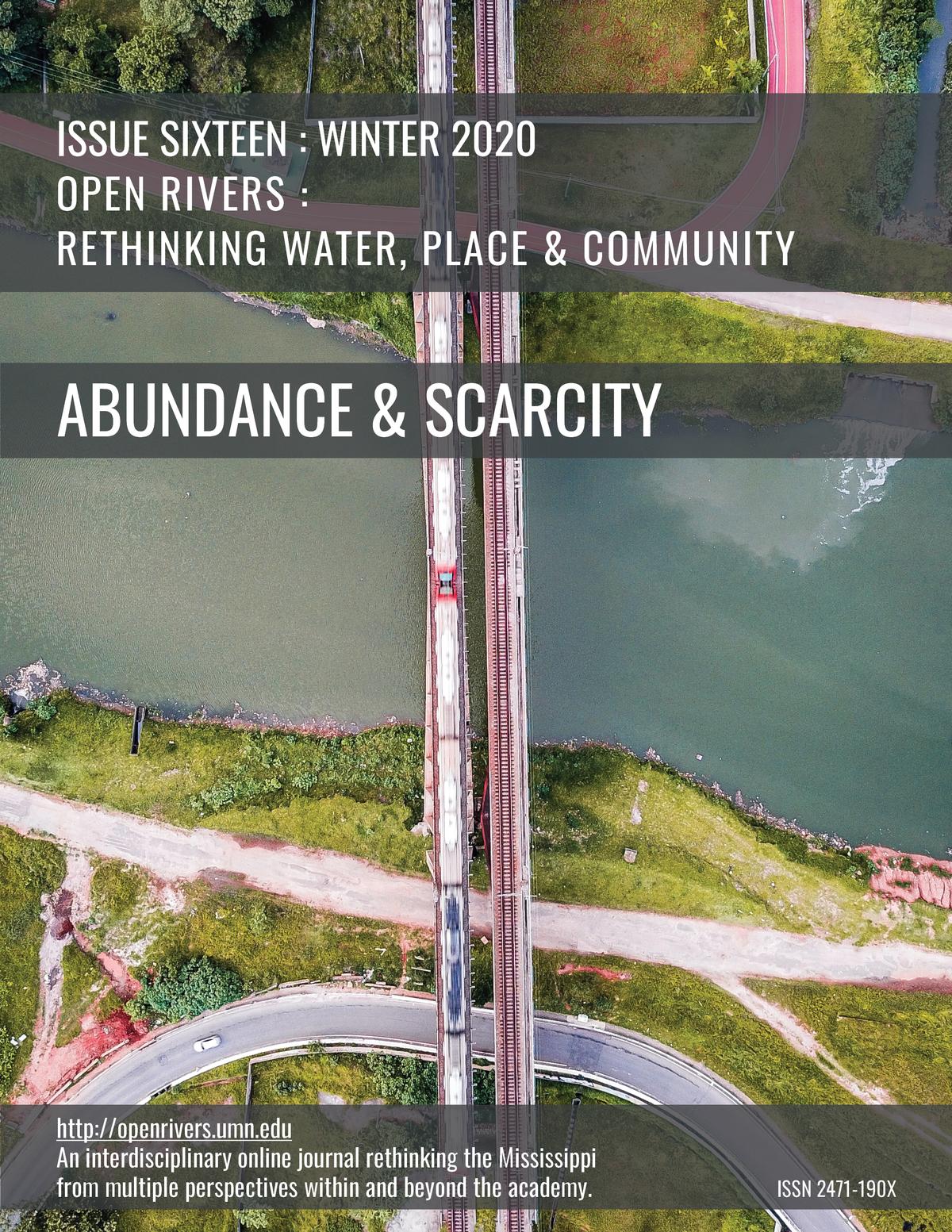Since 2015, the University of Minnesota’s Institute for Advanced Study, in collaboration with the University of Minnesota Libraries Publishing Services Division, has published Open Rivers, a digital journal focused on “rethinking water, place, and community.” Contributors to the journal come from a wide range of academic disciplines and professional backgrounds. Issues are often organized around a central theme, although that theme is sometimes recognized after the issue’s articles have come together. Most, but not all, issues contain writings from an Indigenous perspective. Perhaps befitting the journal’s location at a university that is located in a specific place, there is much here about the Upper Midwest, but there are also important insights from across the country and around the world.
As of summer 2020, Open Rivers had published 16 issues containing 169 articles. What follows is a thumbnail account of each issue, but readers are urged to explore on their own and make liberal use of the platform’s search function to identify work of particular interest.
Issue 1 focused on the prospect of “Knowing” and included reflections from over a dozen scholars and practitioners on how they came to know the Mississippi River and what it meant to them to know the Mississippi.
Issue 2, “Imagining Water,” included three articles from participants in the 2014–15 John E. Sawyer Seminar sponsored by the Andrew W. Mellon Foundation, “Making the Mississippi: Formulating New Water Narratives for the 21st Century.” One of these, Richard M. Mizelle, Jr’s “Princeville and the Environmental Landscape of Race,” has gotten national attention as hurricanes have continued to flood the sections of North Carolina that he wrote about.
Issue 3, “Water, Art, and Ecology,” arose from a panel at the Southeastern College Art Conference in October 2015. Significant features focus on innovative artistic projects that redefine relationships between communities and water.
Issue 4, “Interventions,” addressed a number of perspectives on the Mississippi and Minnesota Rivers in the Twin Cities. This issue probably has more science-based content than any issue previously.
Issue 5, “Networks and Collaboration,” highlighted several of the large scale collaborative efforts taking place to bring people together around shared goals for the Mississippi River, the Gulf Coast, and other waters.
Issue 6 was titled “Provocations” and featured pathbreaking projects from Philadelphia and Los Angeles that re-envision relationships between community and waterways. This issue also contained an article on the “Mapping Prejudice” project, which demonstrates how racially restrictive covenants were placed on homes around Minneapolis’ most-beloved creeks and lakes. This article remains our most-downloaded piece.
“Heritage, Open Space & Water,” the theme for Issue 7, arose from a residency in Spring 2017 jointly sponsored by the University’s Institute for Advanced Study and the Heritage Studies and Public History Masters’ degree program. Articles explore water and mining heritage and changing waters of the Tidal Basin in Washington, DC.
“Grasping Water,” Issue 8, followed a week-long workshop by that name that the Institute for Advanced Study hosted in summer 2016. Scholars from China, Africa, and across North America convened to discuss new pedagogical and research approaches to understanding the histories of water in particular areas of the world.
The focus for Issue 9 was “Innovations,” with substantial explorations of how the Lower Mississippi might become a nationally-significant wilderness, how an island is “written away” from the Mississippi, and what happens when a bar opens serving only water.
Issue 10, “Water @ UMN,” offers a very broad look at the array of water-oriented teaching, research, and programming at the University. Much of this work is from science and engineering disciplines, but there are notable contributions from the humanities and social sciences as well.
Issue 11, on “Paradoxes of Water,” was jointly developed with Augsburg University’s Nobel Peace Prize Forum, which had that theme in 2018. Articles on religious waters and the Nile, on water as an avenue for peace in the Middle East, and other topics brought a global focus to this issue.
Issue 12 had quite a different geography and historical focus. Titled “Watery Places and Archaeology,” two of the three featured articles examined the fur trade era in Minnesota. Two other notable articles included a feature on how bones are analyzed to reconstruct very ancient landscapes and a review/meditation on Ta-Nehisi Coates’ book Between the World and Me.
Water and environmental justice are increasingly understood as powerfully linked concepts and Issue 13 explores many dimensions of these subjects. Read this issue closely and you may never consider water the same way again.
The changing climate was much in the news during 2018–19, and Issue 14 picks up this theme with a series of articles on “Climate, Change & People.” Many of the articles are written by archaeologists and explore changes in material cultures of the past over a long time span, but others consider landscapes inhabited still, closer to home.
Six state agencies in Minnesota, working with host sites around the state, put on a traveling exhibit and series of programs called We Are Water MN. Issue 15, guest-edited by the co-leaders of this statewide program, explores particularly issues of water, story, and community engagement.
It’s a truism that most people only think of water when there is too much of it or too little. Issue 16, “Abundance and Scarcity,” picks this theme up with particular attention to two sites in India and a case study in the Mississippi Delta.
